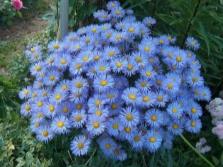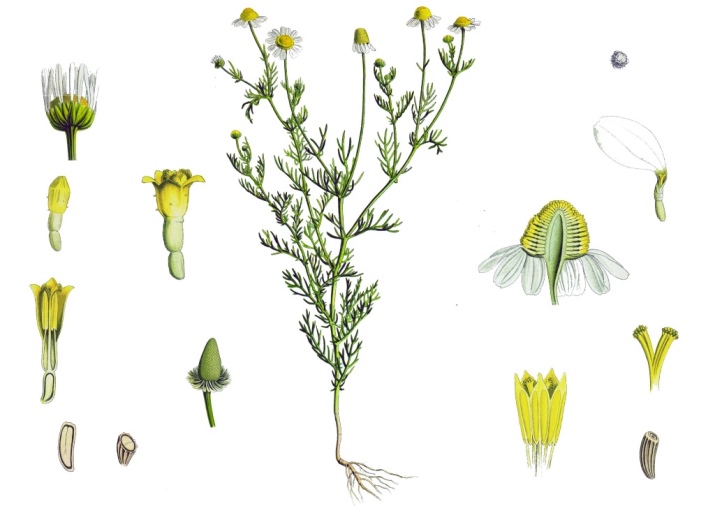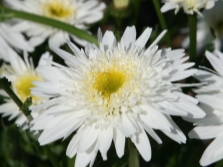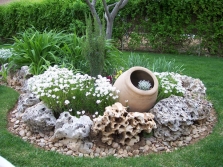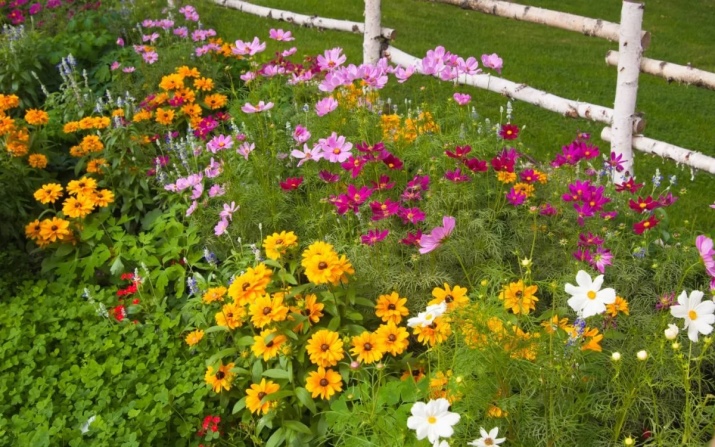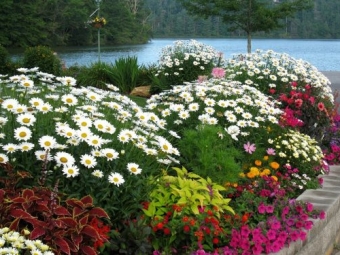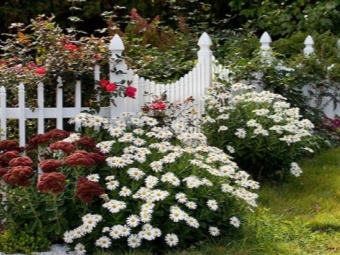Types of daisies
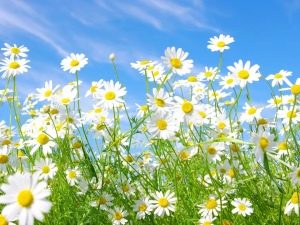
The most beautiful representatives of the flora are undoubtedly flowers. They decorate any space and delight us with their diversity and beauty.They make songs about flowers and devote poems to them, not a single solemn event can do without them, and some representatives of this “kingdom” also have healing properties. The most famous and widespread representatives of them are daisies.
What it is?
From an artistic point of view, chamomile is a simple and delicate flower with a subtle, apple-like, fragrance, fragile creature, absorbed in a piece of sun, which has a modest charm and pure beauty. Bright flowers, childlikely beautiful, delight the eye, delight and inspire poets to poems full of delight dedicated to their extraordinary beauty.
Botanical same description is somewhat different. From the point of view of scientific classification, chamomiles are herbaceous plants belonging to the order of flowering plants, the distinguishing feature of which is the presence of a flower that performs the function of reproduction.
For a more accurate description, scientists attributed this plant to the family of Astrov, or Compositae, selecting it into a separate genus. It has pinnate leaves and inflorescences in the form of a hemisphere. The inflorescence itself consists of two types of flowers: tubular yellow, located in the middle, and white pistillate false-tongues, framing the inflorescence along the edge.
Chamomile is propagated with seeds. It is characterized earlier by flowering, starting from March, and in warmer areas from February and ending in November.
In Latin, daisy is called Matricaria, literally “mother grass”. She received this name not by chance: some plant species have healing properties, especially in the treatment of common female diseases.
Varieties
The habitat of daisies is very wide. In terms of habitat and other characteristics they are divided into all sorts of varieties:
- Wild Chamomile widespread in Eurasia and North America. This species is considered the two most famous species, which are often confused with each other. One species has healing properties and has a characteristic apple-honey smell. This is the well-known pharmacy or as it is also called medicinal chamomile. The second species is not fragrant or trihedral, with a characteristic straight stem and leaves located on it, similar in structure to pharmaceutical chamomile leaves.
- A characteristic feature of medicinal chamomile and its hallmark is the inflorescence with a hollow receptacle. The internal flowers of the pharmaceutical chamomile form a shape similar to a cone, while in the trihedral, the center is flat and even slightly concave. This chamomile got its name for the presence of a number of nutrients.
- Roman chamomile or chamomile noble, as well as pharmacy, has healing properties. The substances contained in it are very close in composition to the medicinal chamomile, so this species is cultivated. This perennial plant grows in Western Europe.
- Another species with its medicinal properties - tongueless odorous chamomile, sometimes it is called peeled for lack of petals. It has a stronger smell compared to the pharmacy. As a rule, this type is used for external use.
- Chamomile can be called plants of the genus pyrethrum. Representatives of this genus Dalmatian, Persian and pink have insecticidal properties, that is, they contain substances that have a destructive effect on insects, but are absolutely harmless to humans and warm-blooded animals.
- Meadow Chamomile, growing in Eurasia, has the botanical name "common cornflower". In common people it is called Popovnik. Although it is not quite true to call this flower chamomile, but in appearance the cornflower is very similar to her. A characteristic feature of this plant are the leaves that have a coherent structure. The breeder does not have any healing properties, but is used by breeders for breeding decorative forms.
- For convenience, they call chamomiles some species of plants from the aster family. Their variety - nivyanik, chrysanthemum daisy. This perennial plant is the ancestor of many forms cultivated for cultivation in the garden. It forms quite tall bushes with single large inflorescences.
Varieties and their names
Various varieties of ornamental daisies were bred to decorate the garden. Every day, these magnificent plants are becoming more and more popular with most gardeners due to their unpretentiousness and undemandingness. The ancestor of each variety is a certain wild-growing species, combining varieties on various grounds.
Varieties derived from common nivyanik differ in the form of petals (reed flowers) and their number, which determines their terry content.
- Plant varieties Krazy daisy reach a height of 90 cm and have beautiful lush inflorescences with a diameter of 10 cm, blooming in July.
- Sort Aglaia slightly lower, its plants reach a height of 50-60 cm, and the inflorescences are slightly larger than those of Crazy.
- Snow lady has large inflorescences, reaching a diameter of 17 cm. But, unfortunately, the plants of this variety do not withstand the winter cold, so more often they are grown as annuals. Unlike him Edelweiss or French chamomile up to 90 cm high, frost-resistant, blooms from July until frost. It stands out for its beautiful inflorescences up to 12 cm in diameter, in shape resemble chrysanthemums.
- In addition to these, there are several other varieties such as: May Queen, Maxima Koenig, Alaska, Beethoven, Viral Suprim other.
Varieties derived from Pyrethrum have one distinguishing feature - fern leaves. The most prominent representatives of this genus are varieties Golden Ball, Carlos, Snow Globe, Paradise and Robinson.
The genus Doronicum became the ancestor of 36 species of garden chamomile. The most popular varieties are Caucasian, Podorozhny and Eastern Doronicum.
Dimensions
The sizes of all cultivated varieties depend on many factors, including the type of wild plant taken by breeders as a basis.
The largest plants belong to the greenhouse. These perennials reach a height of 90 cm and have equally large inflorescences. Thanks to the efforts of breeders, some varieties have been bred, reaching a height of one meter.
The inflorescences of these perennials are appropriate, rather large from 10 to 12 cm, and in the Snow Lady they reach 17 cm. For such impressive sizes, the gardeners gave the nivyanik the alternative name “giant daisy”.
Among nivyanik there are species with more modest size. The marsh nivyanik or the marsh chrysanthemum growing in the south of Portugal and Spain reaches a height of only 25 cm, and its inflorescences have a diameter of 3 cm. In the same modest size, the Kurilian nivyanik is different. This perennial late-flowering plant, common in the Kuril Islands, has a height of 20 cm.
For large species include decorative varieties of feverfew. The height of this perennial plant varies from 50 cm to one and a half meters, depending on the variety.
Among the genus Doronicum there is a species, distinguished by its impressive size, having the name Doronicum porozhenny. The height of this plant reaches 140 cm, and its inflorescences have a diameter of 12 cm. The Caucasian and Eastern species of the Doronicum genus are less modest.
The chamois dye or anthemisis differs in small sizes. Plant height is only 30 cm.
Colors
Representatives of different varieties not only differ in size, but also in hues of inflorescences. Their color range is very extensive and diverse.
- All varieties of cornflower or gigantic chamomile, as it is also called, have a white color of inflorescence. The bright yellow core is surrounded by white petals, differing in shape and quantity in each variety.
- Brightly colored inflorescences are found among feverfews. The yellow heart rises above a rosette of large leaves surrounded by petals (reed flowers) of white, bright pink, crimson, lilac, purple, red, and even burgundy.
- Doronicum is characterized by inflorescences with yellow staining. Shades of reed flowers vary from lemon yellow to orange.
- Antemis or chamomile dye has characteristic bright yellow buds.
A bright and diverse palette of garden chamomiles gives every gardener the opportunity to choose a variety of almost any shade.
Landing methods
In order to grow chamomiles in the garden, special material costs and efforts are not required; even a novice gardener can easily cope with this task. However, it is necessary to take into account some of the nuances characteristic of a particular method of planting:
- Chamomile is grown with seeds. Sowing is carried out either directly into the open ground or first grown seedlings and only then transferred to the open ground.
- Seedlings will require trays with drainage holes that need to be filled with soil consisting of equal parts of peat and sand. The resulting substrate is moistened and placed in it chamomile seeds, lightly sprinkled them. Landings cover with a film and placed in a warm place. Shoots appear after about three weeks. After their appearance, the shelter should be removed, and the tray with the seedlings put on the windowsill, while protecting against drafts.
- When the seedlings reach 5 cm, they are examined and left only by the most advanced ones. Rejected seedlings do not pull out, but gently pinch off the ground surface. For the formation of lateral shoots grown seedlings pinch over the third leaf. In open ground seedlings are planted by the end of spring with the end of frosts. The optimum temperature is favorable for landing +16 C.
- After preparation of the site, the seedlings are placed in the prepared holes at a distance of 20-40 cm from each other. The soil under the seedlings is slightly compacted and watered abundantly.
How to grow daisy without loss is described in the video below.
Examples of use in landscape design
Garden chamomile - one of the favorite cultures, both professionals and amateurs, using it to decorate the landscape.
Unpretentious tender flower looks great not only in single plantings, but also in group, which use the method of combining for different varieties.
The snow-white inflorescences of the berry are perfectly combined with the bright yellow flowers of doronicum in combination with pink, red or burgundy pyrethrum blossoms.
It is possible to combine with each other not only different varieties of daisies, but also to combine one or two varieties with other colors. So the nivyanik having white inflorescences is perfectly combined with scarlet poppies or blue cornflowers. A cornfield with phloxes and lupins will look good. Expressive pyrethrum flowers go well with decorative bells. And the beautiful yellow inflorescences of doronicum look spectacular against the background of marigolds.
It is possible to have single and grouped flower beds along the paths behind the curb using undersized varieties. Near the entrance often make one or two flower beds from varieties with medium growth, but long flowering.
With the help of daisies you can decorate the front garden in a rustic style., combining them with bells, cornflowers, poppies, calendula, nasturtium. You can complement it weaving from willow or hazel.






